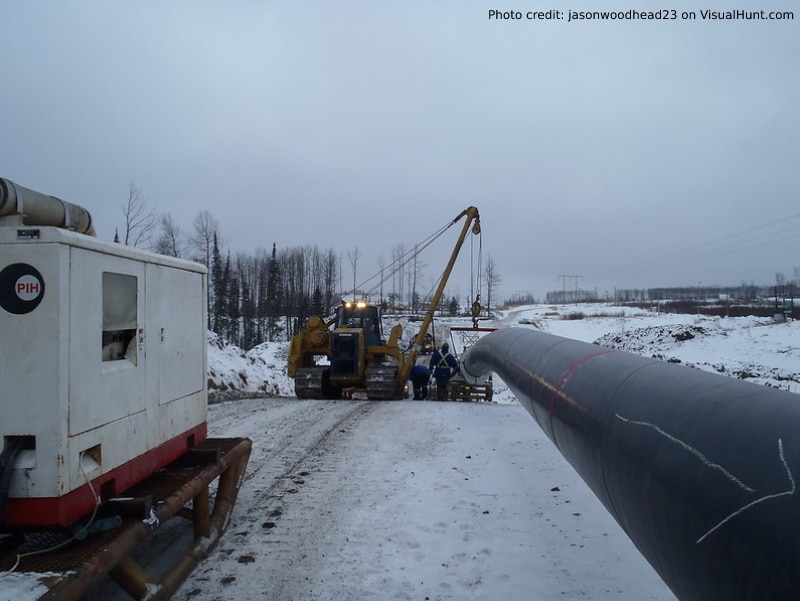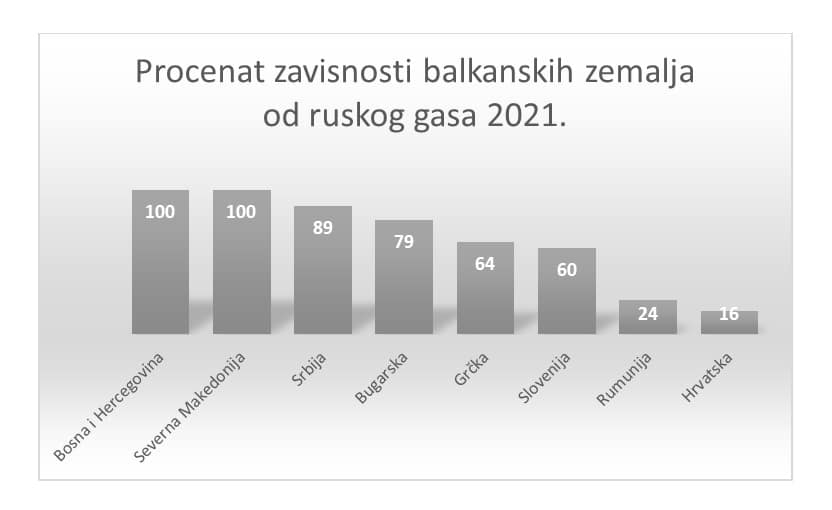
Verzija teksta na srpskom jeziku autora Nemanje Stevanovića dostupna je na sledećem linku: Tekst na srpskom jeziku
The recently concluded agreement between the EU, G7 and Australia and their decision to limit the price of Russian oil to 60 dollars per barrel, the current heating season and the embargo on further delivery of Russian oil via the JANAF (Adria Oil) pipeline have once again brought the issue of energy security into the limelight. As during the 1973 oil crisis, Europe has once again faced economic insecurity after the onset of the Russian aggression against Ukraine on February 24, 2022. The ever-present struggle has been the issue of securing the safe supply of energy sources such as oil and gas to the Old Continent in these new circumstances.
An analysis published by the Eurostat statistical office shows that virtually three-quarters of total gas supplies for the EU countries come from four main sources, that is, from the Russian Federation, the Kingdom of Norway, the People's Democratic Republic of Algeria and the State of Qatar. The same source claims that in 2020, a nearly identical quantity of crude oil was imported for the EU countries’ needs from outside its borders, primarily from the Russian Federation and the United States of America. The Union also imported gas from the Kingdom of Norway, the Kingdom of Saudi Arabia, the United Kingdom, the Republic of Kazakhstan and the Federal Republic of Nigeria. Bearing the above indicators in mind, it is clear that the EU is not only largely dependent on the import of energy products from abroad but that its import is mostly based on energy products coming from Russia. The situation is further complicated by the fact that countries that have not yet become part of the EU, such as Moldova, Bosnia and Herzegovina or North Macedonia, also import and practically solely rely on oil and gas from the Russian Federation.
The Republic of Serbia shares an equally precarious position due to its scarcity of energy networks connected with those in Europe, the unresolved issue of diversification and the Russian monopoly when it comes to energy, and because of the decision not to impose sanctions on the Federation. On top of that, the European Commission’s decision to suspend the delivery of oil through JANAF, the only oil pipeline supplying Serbia with this energy source, has caused an additional problem. Despite all the challenges, it seems that concrete steps have already been taken, especially to provide the Serbian population with gas. For example, a 182-kilometre-long gas interconnector connecting Greece and Bulgaria was commissioned at the beginning of October. The terminal in Alexandroupoli will transport gas from Azerbaijan and its branch, starting in Sofia, is expected to pass through Serbia. The total planned length of the Niš-Dimitrovgrad-Sofia two-way gas pipeline between Serbia and Bulgaria is 170 kilometres, of which 109 kilometres will run through Serbia. The construction work on this project in Serbia commenced on February 1, 2022. The pipeline is designed to transport 1.8 billion cubic meters of gas per year, and the construction work deadline is set for late 2023. According to available information, the project value is 85.5 million euros, of which 25 million euros come from a European Investment Bank loan, the EU’s IPA fund provides 49.6 million euros in grants, while the Serbian national budget and the state-owned Srbijagas are investing almost 11 million euros in this project.
Most countries in the Balkans face problems similar to Serbia’s, regardless of whether or not they are members of the EU and NATO, and all of them are pressured by Moscow officials to resolve the issue of energy sources. Perhaps one of the most obvious examples of this pressure is the instigation of political instability in Bulgaria in June 2022, when a motion of no confidence in the government spearheaded by Kiril Petkov was passed. Having realised how problematic depending on Russian energy sources can be, Europe addressed the need to find alternative and quick solutions by constructing an LNG terminal to receive and store liquid petroleum gas, so as to ensure the smooth functioning of the economy in the event of a supply interruption. In the Balkan region, one terminal was built on the Croatian island of Krk (which is currently being expanded), and the construction of two more terminals is planned in Albania and Romania. However, these alternative solutions can only deal with a part of the consequences but not the true causes of the problem. It, therefore, seems that the only solution for this severe energy crisis is the diversification of energy sources, through which the states would weaken the potential and real pressures of those who export resources, mounting after the start of the Russian invasion of Ukraine. The 2016-built Trans-Anatolian pipeline (TANAP), which obtains gas from the Caspian Sea basin and has distributed it to the Balkans since 2020, gained particular importance in recent months.
In addition to TANAP, which is transporting gas from Azerbaijan via Türkiye to Serbia, an equally important role can be awarded to the Trans Adriatic Pipeline (TAP) that runs from the border between Türkiye and Greece all the way to Puglia, a region in the south-east of Italy, and supplies Greece and Albania with gas as well. The project of the pipeline between Greece and Bulgaria has further built upon the energy network the aforementioned two essential conduits form. The President of the European Commission, Ursula von der Leyen, attended the commissioning of the new gas pipeline on October 1 with the presidents of Bulgaria and Greece and other officials from the Balkans, which portrays how crucial this issue is for the region. If the current geopolitical circumstances are taken into account, the formation of energy networks in the region is vital, and this is exactly what the EU encouraged by allocating almost 250 million euros from various funds to support this project.

Despite having originated from the European Economic Community, whose goal was to secure the free market, in light of recent events, the EU’s financing of energy diversification projects can be interpreted not only as an economic but also a political move aimed at empowering these two spheres of the Union. A majority of member countries, especially those that initiated Euro-Atlantic integration after the fall of the Berlin Wall, meanwhile detected the vulnerability a large dependence on Russian resources causes in the energy sector. According to the available data from 2021, more than half of the imported Russian gas was distributed to the former Warsaw Pact countries. In the previous year, the percentages of Russian gas comprised in total imports per country are as follows: Slovakia (68 per cent), Hungary (61 per cent), the Czech Republic (55 per cent), and Poland (50 per cent). With the imposition of sanctions against Moscow after the beginning of the invasion of Ukraine, these countries were declared hostile by the Russian Federation, which made finding alternative ways of supplying and securing necessary energy resources a priority for them.
The Balkan countries are facing a somewhat different situation, seeing that the biggest alternative to Russian gas, embodied in the TAP and TANAP pipelines, already exists in the peninsula. Although this is a good starting point for further diversification, a glaring problem is that TAP cannot yet pass through all countries, which may cause an even more complex security situation in the Balkans, where countries would constrain each other. On the other hand, Russia will certainly not allow anyone to take away its energy primacy in the region, currently upheld through the Turkish Stream – one of the channels Serbia is also supplied from. Neither TAP nor the Turkish Stream cover the entire peninsula, which is why two more projects are in the pipeline: the Ionian Adriatic Pipeline (IAP) connecting Fier in Albania and Split in Croatia, and the Tesla Gas Pipeline, planned to link Greece and Austria.
Given Serbia's position, the most likely current alternative seems to be interconnecting to the pipeline branch between Greece and Bulgaria, with the key issue being the feasibility of fully connecting to this gas pipeline by the end of 2023. Namely, some experts doubt that Serbia will achieve this in the estimated time, primarily because it is necessary to evaluate the capacity of the original gas pipeline, the pressure in the conduits and all other accompanying elements before delivering the required quantities of gas.
Sanctions imposed by the EU and the actions taken by Moscow officials were not only aimed at resolving the issue of uninterrupted gas supply. The eight packages of sanctions the EU introduced against Russia caused an acute oil crisis that subsequently spilt over into the Balkans. A shortage of oil pipelines represents a severe disadvantage of this region, as only two conduits form the backbone of energy product delivery. One of them connects Burgas in Bulgaria and Alexandroupoli in Greece and is a core energy hub of both Greece and the Balkans, while JANAF is the other pipeline, supplying Croatia, Serbia, Slovenia and Bosnia and Herzegovina with oil. As a country mostly depending on the oil transported via the JANAF pipeline, Serbia is now very vulnerable in terms of energy, and the state is additionally affected by the privatisation of the Petroleum Industry of Serbia (Naftna Industrija Srbije), which was sold to Russia's Gazprom. After a bilateral meeting with Hungarian officials, an agreement to construct a pipeline was reached in an attempt to respond to the current global circumstances. Through this conduit, Serbia will be supplied with oil from Hungary, whose main source of this energy product is the largest European oil pipeline named Druzhba (the Friendship Pipeline).
Although securing two independent sources of supply would significantly increase the stability of the energy system in Serbia, the issue would essentially not be solved because a new branch would not inherently diversify sources, but only represent new routes through which Russian energy products would be delivered. In order to improve this situation in the future, the real alternative lies in projects that have been more or less successfully developed for years. Thus, the construction of two pipelines is expected to begin soon: the first one is the AMBO oil pipeline, connecting Bulgaria, North Macedonia and Albania, and the second one is the very ambitious Pan-European Oil Pipeline, which would interconnect Constanţa in Romania and Trieste in Italy, passing through Serbia, Croatia and a part of Slovenia. Bearing all this in mind, it seems that a parallel can be drawn between the issues of uninterrupted delivery of oil and gas. Namely, countries are actively putting in the effort to diversify and find alternative solutions, build new terminals, and oil and gas pipelines, and organise bilateral and multilateral meetings of the highest officials more frequently. Serbia is also striving to diversify energy sources, and in addition to relying on the gas interconnector and oil pipeline project developed with Hungary, the country is seemingly seeking aid in resolving issues in the energy sector from Norway and other Scandinavian countries.
Translated and proofread by: Milica Milosavljevic
Author: Nemanja Stevanovic


